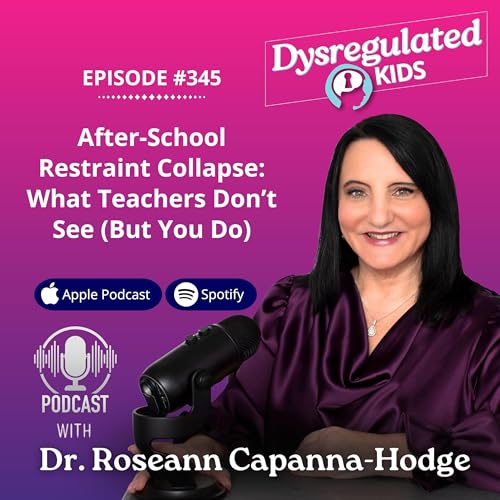
345: After-School Restraint Collapse: What Teachers Don’t See (But You Do)
No se pudo agregar al carrito
Add to Cart failed.
Error al Agregar a Lista de Deseos.
Error al eliminar de la lista de deseos.
Error al añadir a tu biblioteca
Error al seguir el podcast
Error al dejar de seguir el podcast
-
Narrado por:
-
De:
You hold it together all day at work, only to walk in the door and snap at the first person you see. Sound familiar? That’s exactly what your child is experiencing when they come home from school—and you’re not alone in wondering what on earth is happening.
After-school restraint collapse is real. Many parents feel overwhelmed when their child holds it together for teachers, only to unravel at home. In this episode, I explain why this happens and share practical steps so you can help your child regulate, reset, and reconnect after a long day.
Why does my child melt down after school?
What looks like defiance or disrespect is really your child’s nervous system waving the white flag. After a long school day filled with demands, noise, and social stress, many kids come home emotionally depleted.
It’s not bad parenting—it’s a dysregulated brain. Your child held it together in class, but once they feel safe at home, the emotional floodgates open. This isn’t rebellion—it’s release.
Here’s what’s really happening behind those after-school meltdowns:
- Kids mask stress at school and let it out at home where it feels safe.
- Common triggers include: sensory overload, skipped meals, transitions, and sheer fatigue.
- Behavior is communication. Tears, shutdowns, or outbursts signal that your child’s nervous system needs recovery—not punishment.
When parents reframe restraint collapse as a call for regulation, it shifts everything.
🗣️ “Instead of feeling frustrated or questioning your parenting, you can focus on helping your child reset. And that’s where real change begins.” – Dr. Roseann
How can I help my child calm down after a long school day?
Before homework, before chores, before questions—your child needs decompression time. Think of it as their reset button.
- Create a calm landing zone. A dim room, quiet time, or cozy corner gives kids space to exhale.
- Co-regulate first. A soft voice, gentle breath, or even silence helps send the message: You’re safe now.
- Offer a healthy snack. Protein and complex carbs stabilize blood sugar and energy.
- Delay tasks. Regulate first, then tackle homework or family responsibilities.
When your child is dysregulated, it’s easy to feel helpless.
The Regulation Rescue Kit gives you the scripts and strategies you need to stay grounded and in control.
Become a Dysregulation Insider VIP at www.drroseann.com/newsletter and get your free kit today.
What are the best after-school routines for emotional regulation?
Every child is different, but all kids benefit from structure. A predictable routine helps prevent restraint collapse and supports your child’s emotional well-being.
- Build in movement. A walk, trampoline, or dance session resets the brain and body.
- Mix in play and connection. Even 10 minutes of relaxed play or conversation signals, I see you.
- Offer simple choices. Ask, “Do you want music or quiet?” “Snack now or later?” Giving small control reduces frustration.
- Avoid devices right away. Screen time may feel like a shortcut to calm, but it pulls kids further from emotional regulation.
How do I know if my child’s after-school meltdowns need professional help?
Some kids bounce back with consistent routines, but for others, restraint collapse is a clue their nervous system needs more...



